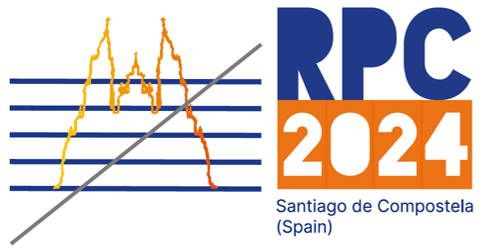Speaker
Description
One of the key challenges in R&D strategies for RPCs is the replacement of currently used C$_2$H$_2$F$_4$ and SF$_6$ with environmentally friendly alternatives. Usually, the C$_2$H$_2$F$_4$ is replaced by a proper mixture of C$_3$H$_2$F$_4$ and CO$_2$, while CF$_3$I, C$_4$F$_7$N and C$_5$F$_{10}$O were considered as alternatives to SF$_6$. In the first part of this work, we propose complete and consistent sets of cross sections for electron scattering in C$_3$H$_2$F$_4$ and C$_3$HF$_5$. The cross sections are validated through a series of comparisons between swarm data calculated using a numerical solution of Boltzmann's equation and Monte Carlo simulation, and experimental data obtained under pulsed-Townsend conditions. Swarm analysis has also been performed for CF$_3$I, C$_4$F$_7$N, and C$_5$F$_{10}$O and gases, which are considered as potential replacements of SF$_6$ in typical RPC mixtures. Other sets of cross sections for these gases that are available in the literature are also used as input in our numerical codes to test their completeness, consistency, and accuracy. In particular, we discuss the dependence of transport coefficients on the pressure, temperature, and composition of RPC gas mixtures made of these gases. We also study the explicit and implicit effects of non-conservative collisions on the transport of electrons and the induced kinetic phenomena such as negative differential conductivity.
In the second part of this work, we study the development of an electron avalanche and its transition into a streamer discharge in environmentally friendly RPC gas mixtures under LHC-like conditions. Recently, we have developed a 3D streamer model in the AMReX environment. AMReX is an open-source C++ library for massively parallel block structured adaptive mesh refinement applications. AMReX has in-built geometric multigrid solvers for solving elliptic differential equations, and it supports MPI and OpenMP parallelization on CPUs as well as parallelization on GPUs. The classical fluid model, which involves the drift-diffusion approximation and local field approximation, is implemented assuming a certain level of background ionization to simulate the inception and propagation of positive streamers. The time integration is performed by employing the second order Runge-Kutta method, while the spatial discretization is performed by using the finite volume method. We calculate the electron and ion densities, electric field, and velocity of streamers as a function of the applied electric field for various RPC mixtures. We also look at the development of electron avalanches in the presence of space charge effects. The results of these simulations, in association with the scattering and transport data for electrons in environmentally friendly RPC gas mixtures, should be considered in experimental measurements and modelling efforts to test the performance of RPCs.
Acknowledgment: This work is supported by the Science Fund of the Republic of Serbia, Grant No. 7749560, Exploring ultra-low global warming potential gases for insulation in high-voltage technology: Experiments and modelling EGWIn.

